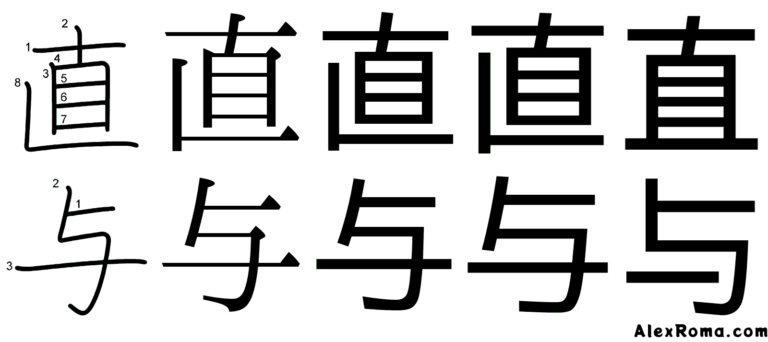Stroke order rule 6 – horizontal skewer last

A horizontal stroke that pierces a whole shape and protrudes from both sides is written last.
I call such strokes “horizontal skewers”.
The diagram below contains a good selection of common kanji with horizontal skewers.
Remember that we are talking about horizontal strokes that protrude on both the left and right side. Strokes that don’t protrude behave differently. If you practise writing these shapes you’ll realise that this rule is very “natural”. Even without knowing anything about stroke order rules, you would probably write the skewer-stroke last.

Before we move on to the exceptions, allow me to open a small parenthesis.
Character styles
You may have noticed that the shapes of kanji visualised on a webpage, printed on a book, or written on a piece of paper can be remarkably different. These differences are just a stylistic choice and should not concern us in our study of kanji stroke order.
The following diagram should help clear things up.

The diagram shows the kanji 直 CHOKU and 与 ataeru in five different font/styles. You can see how the kanji in the fifth style on the right (for both characters) almost look like completely different characters.
I would like you to especially notice the character 与 ataeru, where the piercing horizontal stroke becomes an isolated stroke that doesn’t intersect any other stroke. It is therefore important to apply our stroke order rules to the “standard shapes” we refer to in this guide and in kanji dictionaries.
Exceptions: skewers that are written first
Our three main exceptions are:
- the 世 yo ‘world’ shape;
- the lower-half shape in 弁 BEN ‘speech’;
- the “grass” crown shape 艹 kusakanmuri.
These three shapes are extremely common and can be easily learned with the wrong stroke order because of how counter-intuitive they are.

It is important that you practice the shapes presented in the diagram.
On a side note: if the kanji 世 yo reminds you of the hiragana せ se, it’s not a coincidence. The kanji 世 yo ‘world’, with the ON-readings SEI and SE, is where the hiragana せ se comes from.
The hiragana せ se is the cursive form of the kanji 世 SE. This fact is clearly reflected in the stroke order, and it is a perfect example to show how important it is to know stroke order to correctly interpret cursive writing (handwriting).

Let’s move on to the next group of exceptions. The diagram below presents more characters with piercing horizontal strokes that take precedence over the intersecting strokes.

Like before, the only way to remember these exceptions is to practice them until we become perfectly comfortable with the correct stroke order, and especially 無 MU which is one of the most common and useful kanji because it is used to negate words and meanings; for example: 無関心 mukanshin ‘indifference/apathy’, 無力 muryoku ‘powerless’, 無礼 burei ‘rude/unpolite’.
